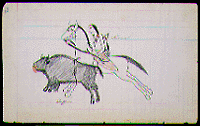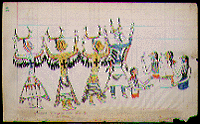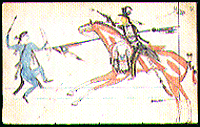
Ledger Drawings – Then and NowExplore these vivid compositions created by Plains Indians |
 |
Image: Howling Wolf, Southern Cheyenne is considered the most significant Plains artist of the last half of the nineteenth century. This drawing in pencil, colored pencil, ink, and crayon on ledger paper is represented in Howling Wolf and the History of Ledger Art by Joyce M. Szabo, published by University of New Mexico Press, Albuquerque. |
 |
Image: Hunting buffalo From Kiowa Memories - Images from Indian Territory, 1880 by Ronald McCoy, published by Morning Star Gallery |
The pages, framed and hung in galleries and museums, make a statement that is more than the sum of their narrative and esthetic parts. With telling line and sophisticated use of space, the carefully observed scenes of a long gone culture spring to life against the ruled ledger sheets. The imagery is especially interesting because it is not influenced by European tastes. The Dorothy Dunn school of painting and the tourist-oriented "Bambi" style, wonderful though they were in their own right, were yet to come. The ledger drawings were still rooted in their own culture. They are direct expressions of a centuries-old tradition of art. The Plains Indians had long been known for their pictographic art and for their sophisticated use of line and color in ritual and utilitarian objects. Their parfleches, or saddle bags, were embellished with bold abstract designs. Their shields and ornaments were designed to impress friend and enemy alike with their distinctive character and fine workmanship. Every last detail of their clothing and shelter exhibited an integrity of concept that pervaded their domestic and ritual life. |
 |
Image: Mountain Spirit Dance From Kiowa Memories - Images from Indian Territory, 1880 by Ronald McCoy, published by Morning Star Gallery |
 |
Image: Sitting Bull dressed for war meets his enemy This drawing is represented in The Edwards Ledger Drawings: Folk Art by Arapaho Warriors, Karen Daniels Petersen, Jean Afton, David A Schorsch, Inc. |
Their pictographic imagery was most often used in rock art, or petroglyphs. In abstract symbolism and narrative representation, the early Indians set down records of their passing. Historians and anthropologists have studied these records on stone for clues to ancient mysteries and the movement of prehistoric peoples. What they believed, what they hoped and what they actually did may be deciphered from their drawings. In some cases, particularly at Chaco Canyon, their symbols even functioned as a calendar device to track the seasons like a great sundial. Pictographs were also inscribed on buffalo robes. In this case, they described the deeds of the wearer, serving as a kind of court dress or status symbol. In a few cases, these robes have proven to be valuable archives in their own right because they depict important events in Native American history. It was natural, then, for the colonized or captured Indians of the nineteenth century to incorporate their rich artistic heritage into the images they drew in ledger books. The comparative ease of pencil and paper over ground pigment and primitive brush served to free their drawing techniques without compromising the purity of their style. Thus inspired, they set down history and myth, real and imaginary events, battles and dreams. They combined rich, precise details of costume with a sophisticated economy of line and use of negative space. They invented a kind of symbolist shorthand to describe complex ideas. Speech or song was indicated by a dotted line emerging from the mouth. An advancing militia might be rendered as a row of smoking guns. Swift movement was shown by a ghost of a trail, more than half a century before cartoonists began using that idea commercially. The ledger artists also foreshadowed Cubism in their depiction of a horse, for instance, viewed simultaneously from the front and the side. The horses are also stylized with arched necks, small heads and outstretched legs to emphasize their form. The emotional content of the drawings, though not the stylistic conventions, embodies Expressionist ideas that had not yet appeared in European art. Perhaps this fervent quality shows that the artists knew that their traditional way of life was about to disappear forever. Faced with the loss of their identity, they made a heroic effort to chronicle the tumultuous events of the frontier as well as the customs and legends of their people. With precision and passion, they created an elegy that fairly sings with the beauty of their visual language. Small wonder, then, that some contemporary Indian artists pay homage to this proud tradition by adapting it to their own ideas. Tim Lammers, an Oglala Sioux, is an ardent preservationist who works entirely in the traditional mediums that preceded ledger books and pencils. His pictographic images, incorporating geometric designs as well as realistic figures, are inscribed on braintanned buffalo hides, which are displayed on the wall in the manner of paintings. Lammers also makes a wide variety of traditional Plains objects, including medicine wheels, pipe bags, headdresses, and children's games and toys. He is widely recognized for the authenticity and fine craftsmanship of his quillwork, plaiting and beadwork, and for his tireless efforts to encourage others to participate in the perpetuation of their artistic legacy. A different approach altogether is taken by Benjamin Nelson, a 14-year-old Kiowa-Navajo-Taos prodigy who has already carved out his own niche in the art world. For several years, he has been an exhibitor at the annual Santa Fe Indian Market, and has sold out his fifty or more paintings on the first day of Market. Nelson's paintings resemble ledger drawings in their pictographic imagery and their complexity. But, in place of the ruled ledger paper, he creates a unique airbrush background of cloudlike ridges and ghostly horsemen, buffalo and deer. They function as the artist intended, as ancestral figures. It is a stunning visual metaphor, not only for mythical times but for the continuing life of the ancient pictographs themselves. Likewise, the early pieces assert their timeliness in the modern world. Their narratives are relevant, and their imagery is as strong as any contemporary work. Their message is about the integrity of Indian artistic traditions, yesterday, today and tomorrow |
By Suzanne Deats, who is also author of Art 101 All images courtesy of Morning Star Gallery Originally appeared in |
Collector’s Resources |
|
RESOURCE LISTS UPDATED WHEN VIEWED | ARTICLE CONTENT REVISED September 24, 2007 |